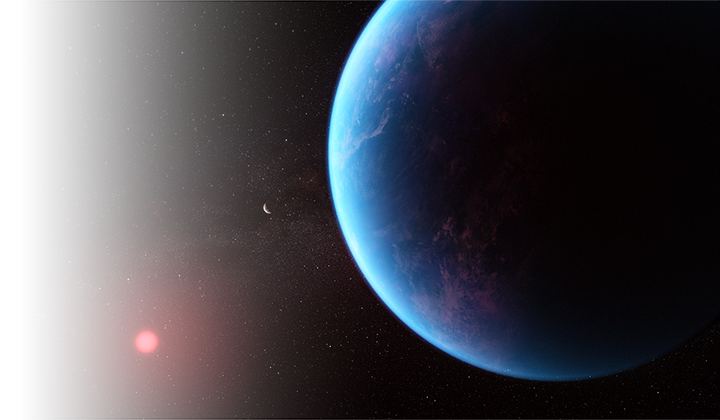Q. What is a hycean world?
A hycean world is a type of exoplanet with an ocean-covered surface and an atmosphere dominated by molecular hydrogen (H2), with the environmental conditions in the ocean similar to those suitable for life in Earth’s oceans.
Q. Why are hycean worlds considered potentially habitable?
Hycean worlds are considered potentially habitable because they have conditions suitable for liquid water to exist, an essential ingredient for life as we know it on Earth. Furthermore, many life forms on Earth are known to thrive in hydrogen-rich environments, such as those found on hycean planets.
Q. How do scientists identify hycean worlds?
Scientists first identify a candidate hycean world based on its mass, radius, and average temperature, derived from its distance from the host star. These parameters can suggest if the planet could be a hycean world but are not enough to conclusively determine the composition. Further spectroscopic observations are used to assess the atmospheric composition of the planet which in turn determines whether there is evidence for an H2-rich atmosphere with a water ocean underneath it as expected for a hycean world.
Q. Could hycean worlds support life as we know it?
Due to the presence of oceans with similar conditions to those found in Earth’s oceans, hycean worlds are expected to be conducive for life. However, the nature of potential life on such planets is presently unknown.
Q. How many hycean candidates are currently known?
Considering the bulk properties alone, i.e. planet mass, radius and equilibrium temperature, nearly 15 hycean candidates are currently known to orbit M dwarf stars within 150 light years. These candidates could be hycean worlds but other scenarios that are possible for sub-Neptunes cannot be ruled out with the bulk properties alone. Atmospheric observations are required to distinguish between the different scenarios. Currently, two promising candidates are known that have atmospheric observations conducted with JWST with the derived composition being consistent with predictions for a hycean world. These are K2-18 b and TOI-270 d.
Q. How far are the nearest hycean candidates?
Currently, the nearest promising candidate hycean world is TOI-270 d, around 70 light years away. The other promising candidate, K2-18 b, is 124 light years away. The discovery and characterization of other potential hycean planets are ongoing.
Q. Are there any ongoing missions specifically focused on studying hycean worlds?
While no space missions are specifically designed to study hycean worlds, the JWST is well equipped to conduct detailed atmospheric observations of candidate hycean worlds. Such observations have been reported for two hycean candidates with more underway. PLATO, the Habitable Worlds Observatory, and the Earth 2.0 mission, will each be able to detect more candidate hycean worlds.
Q. How might the discovery of biosignatures on hycean worlds impact our understanding of life beyond Earth?
Detecting biosignatures in these worlds would suggest that life can thrive in diverse environments beyond Earth-like planets, significantly shifting our approach to the search for extra-terrestrial life and increasing the likelihood of finding life elsewhere in the universe.
Q. What are the possible internal structures of sub-Neptune planets?
Sub-Neptunes are planets with radii between around 1.5 and around 4 times that of Earth. Based on the mass and radius measurements, three types of internal structures are possible for sub-Neptunes: a mini-Neptune, a gas dwarf or a hycean world, as discussed here. However, atmospheric observations can be used to distinguish between these scenarios. In particular, the mini-Neptune and gas dwarf scenarios both involve deep H2-rich atmospheres, whereas a hycean scenario involves a shallower H2-rich atmosphere over a liquid water ocean. Atmospheric observations can be used to distinguish between these scenarios.
Q. Is K2-18 b a mini-Neptune?
Based on the mass and radius alone, a mini-Neptune scenario would be one of the three possible scenarios for a sub-Neptune like K2-18 b. However, the observed atmospheric composition of K2-18 with JWST is inconsistent with a mini-Neptune scenario. An initial study suggesting the mini-Neptune scenario (Wogan et al. 2024) was found to be incompatible with the retrieved abundances (Glein 2024, Cooke & Madhusudhan 2024), in particular the non-detection of NH3 and a high CO2/CO ratio.
Q. Is K2-18 b a gas dwarf with magma oceans?
As noted above, a gas dwarf scenario is one of three possible scenarios used to explain the mass and radius of K2-18 b. However, similar to the mini-Neptune scenario, the observed atmospheric composition is incompatible with a deep H2-rich atmosphere required for a gas dwarf scenario. Models with a hot gas dwarf interior with magma oceans (Shorttle et al. 2024) were found to be incompatible with the atmospheric abundances and/or physically implausible (Glein 2024, Rigby et al. 2024).
Q. Is there an ocean on K2-18 b?
Presently, the only scenario that explains the mass and radius as well as the observed atmospheric composition is one in which K2-18 b has a large amount of water in the interior under a relatively shallow H2-rich atmosphere. The observed composition is consistent with prior predictions of a hycean world, e.g. a low atmospheric abundance of NH3, which is highly soluble in water, a high atmospheric CO2/CO ratio due to a shallow atmosphere, and a low atmospheric abundance of H2O due to a cold and dry stratosphere as on Earth. However, the surface pressure and temperature of a possible ocean and whether it is habitable is currently unknown, allowing for both habitable and non-habitable conditions compared to Earth’s oceans.
Q. Can dimethyl sulphide (DMS) be produced abiotically?
On Earth DMS is known to be produced uniquely by life and has been predicted to be a robust biosignature for exoplanets (Domagal-Goldman et al. 2011, Seager et al. 2013). Biosignature molecules such as DMS and oxygen (O2) can be produced abiotically in small quantities in space environments such as comets (Hanni et al. 2024) and the interstellar medium (Sanz-Novo et al. 2025) and through photochemistry in gas mixtures containing H2S and CH4 (Reed et al. 2024). However, there is no known abiotic mechanisms to produce DMS at detectable abundances (i.e., above several parts per million) in a planetary atmosphere similar to that of K2-18 b, nor can DMS be delivered in measurable quantities through comets. DMS is a very unstable molecule which can be readily destroyed in planetary atmospheres that contain CO2 or H2O and is not expected to be present on hycean planets without a substantial production flux from living organisms e.g., Tsai et al. (2024).
Receive Email Updates
As we add news and content to the website, we'll email you to keep you updated!


